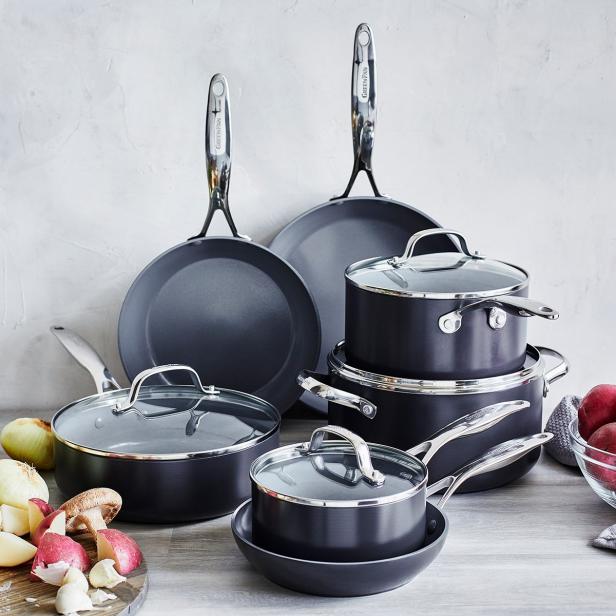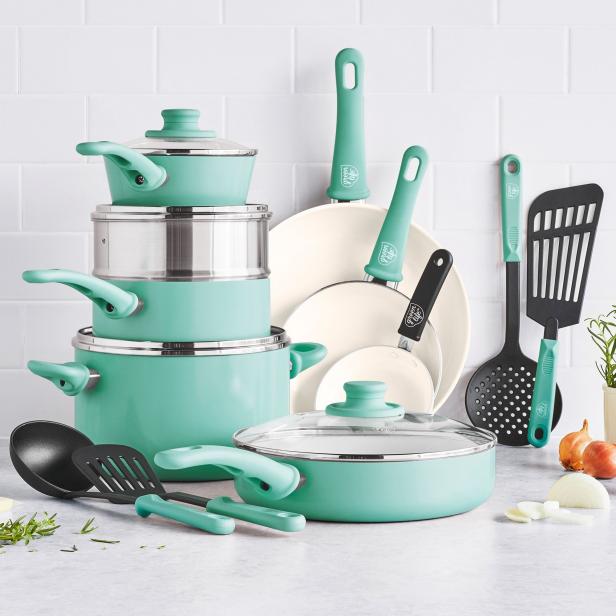
We all enjoy getting new pots and pans, however some coatings are actually dangerous to your health. We are going to take a look at some.
Disappointing Information
While it’s not something anyone wants to believe, a fair portion of cookware and storage containers are laced with toxins that can build up in the body and compromise your health. The chemicals found in common things like pots and takeout containers have been linked to everything from infertility and weight gain to neurodegenerative diseases like Parkinson’s. That said, it’s in your best interest to do a serious inventory of your cookware.
Aluminum

If you’ve ever roasted veggies or fish in the oven, you probably used aluminum foil. And if you’ve ever baked a lasagna to bring to a potluck, you may have made it in a throwaway baking ban. But you may want to reconsider going heavy metal. A recent article from The Journal of Alzheimer’s Disease linked the consumption of aluminum to Alzheimer’s and other neurodegenerative diseases like Parkinson’s.
Safe Alternatives: Parchment Paper, Glassware or Porcelain
Perfluorooctanoic Acid
Found in: Certain non-stick pans
The invention of the non-stick pan was considered a miracle among dish-duty haters everywhere; it makes cleanup super simple. But have you ever wondered what makes these pans so magical? Most non-stick pans are coated with Teflon, which is laced with something called perfluoroctanoic acid (PFOA). The chemical has been linked to infertility, weight gain, and
impaired learning. What’s more, the International Agency for Research on Cancer has classified PFOA as possibly carcinogenic to humans.
Bisphenol A
Found in: Certain water bottles, plastic storage containers, plastic strainers, pitcher-based water-filtering systems, plastic takeout containers, resealable snack bags, plastic cutting boards, metal can liners
If you have one of these fancy stainless steel reusable water bottles, it’s likely because you’ve heard about the dangers of BPA, a hormone-mimicking chemical commonly found in water and soda bottles. But here’s the thing: BPA—which has been connected to cancer, decreased brain and heart health, and even infertility—isn’t just found in bottles of H20 and pop
. A lot of cookwares, storage bags, pitcher-based water filters, and food containers are made with BPA-laced plastics, too. The worst part? When heated, the toxic effects of the chemical become even more dangerous. This is especially true when cooking acidic, fatty, and salty dishes.
When heated in plastic, these kinds of foods increase the migration of BPA into your food. If we haven’t convinced you yet that life is not-so-fantastic with plastic, consider this: A recent study from Harvard University found a connection between BPA consumption and obesity—even for people who only ingest a small amount. Yes, you read that right: storing and zapping your food in plastic could undo all of those hard-earned weight loss wins.
Safe Alternatives: Glass, Food-Grade Steel,
Vinyl Chloride & Polyvinyl Chloride

Found in: “BPA-free” plastics, cans and containers, food storage bags, shrink wrap
Polyvinyl chloride (PVC) or #3 plastic is made from something called vinyl chloride, which is
recognized as a human carcinogen by the National Toxicology Program, a division of America’s National Institutes of Health. It’s commonly found in products marked with the “BPA-Free” sticker, including cans, food storage bags and shrink wrap.
Polyethylene Terephthalate
Found in: Food storage containers
BPA isn’t the only chemical hiding in your food storage containers. If you tend to reuse things like mustard bottles and soda bottles to store your own homemade creations, you could be exposing yourself to polyethylene terephthalate (PETE). While plastics that contain this chemical aren’t completely awful for one-time use, as this material gets used again and again it can break down and begin to leach carcinogenic, hormone-disrupting phtalates into your grub. A study in Environmental Health connected higher exposure to the chemical toxins with metabolic syndrome, a disease also commonly associated with increased levels of inflammation. (More on that in our special report, 14 Foods That Cause Inflammation.)
Polystyrene
Found in: Opaque plastic cutlery, Styrofoam carryout containers, cups, and bowls
If your favorite takeout joint typically sends their food to your front door in Styrofoam carryout containers, consider your meal ruined. Styrofoam is made out of polystyrene (a possible human carcinogen), which can leach into your food and drink. The same thing can happen if you use the opaque plastic cutlery that many restaurants throw into the delivery bag.
Phthalates
Found in: Soda bottles, cheap straws
If you reuse soda bottle to make homemade iced tea, it’s time to start considering some safer alternatives. Because in this case, recycling is only going to put your health at risk. As it’s used time and time again, your beverages will wear down the plastic bottle, causing it to leach toxic chemicals like phtalates into your drink. Used to keep plastics super soft, studies suggest that the estrogen-mimicking chemicals can cause respiratory problems and developmental, learning and behavioral problems in children. Phtalates have also been linked to metabolic syndrome and inflammation
Brominated Flame Retardants
Found in: Plastic kitchen and cooking utensils
Do a quick mental inventory of your kitchen. Do you have things like plastic spatulas and slotted spoons stored in your drawers? If you’re shaking your head yes, go home and toss them out. There’s a chance these cooking utensils are coated in bromine, a component in brominated flame retardants, or BFRs. While the chemical may ensure that your spoon won’t catch fire if you leave it too closes to the burner, when exposed to friction or heat—as many kitchen utensils are—BFRs can become released and go into your food.
When expectant moms are exposed to BFRs, their babies can experience lower birth weight and length, as be born with smaller head and chest circumferences, according to a 2014 study in the journal Environment International.
The only way to completely avoid these chemicals is to dine at an uber-organic and environmentally-friendly eatery or forgoing eating fast food altogether—which wouldn’t be the worst change to your diet, now would it?
After reading this article, I feel that to stay healthy you should just cook your own food and stay at home using safe utensils and pots and pans.
Top Non-Toxic Cookware Picks:
- Best Overall: Caraway Home Cookware Set
- Most Versatile: Our Place Always Pan
- Best Set: Green Pan Valencia Pro 11-Piece Cookware Set
- Best Budget: GreenLife Soft Grip Set
- Most Durable: Extreme Versa Skillet
- Best Stainless Steel: All-Clad d3 Cookware Set
Best Set: GreenPan Valencia Pro 11-Piece Cookware Set
$349.99 $301 GREEN PAN14% Off
For those looking to truly overhaul their cookware cabinet, look no further. This GreenPan set includes 8-, 9.5- and 1WALMART 1-inch fry pans, 2- and 3-quart saucepans with lids, a 3-quart sauté pan with lid, a 5-quart stockpot with lid and three pan protectors. Transitioning from stove top to oven is a breeze with even heating pots and pans being oven/broiler safe up to 600F. While hand wash is recommended, they are dishwasher (and metal utensil!) safe for speedy clean-up.
$500 | Green Pan $350 | Amazon
Best Budget: GreenLife Soft Grip
$119.99 $85 AMAZON30% Off
“Healthy” doesn’t have to break the bank. For less than $100 (ideal for college kids moving into their first off-campus apartment!), you can cook everything with this 16-piece set from pancakes to perfectly seared seafood without a single frustrated scrape. Lightweight — thanks to being crafted from recycled aluminum — these punchy-colored, ceramic-coated nonstick pots and pans are made from sand and claim to emit 60 percent fewer CO2 emissions versus traditional nonstick competitors. Also, noteworthy: The four clear lids, which help you keep tabs on meal prep progress.No need to let your fire alarm alert you that dinner is ready!
$120 | GreenLife
WALMART also carries non toxic plastic cookware along with pots and pans. Amazon to!


